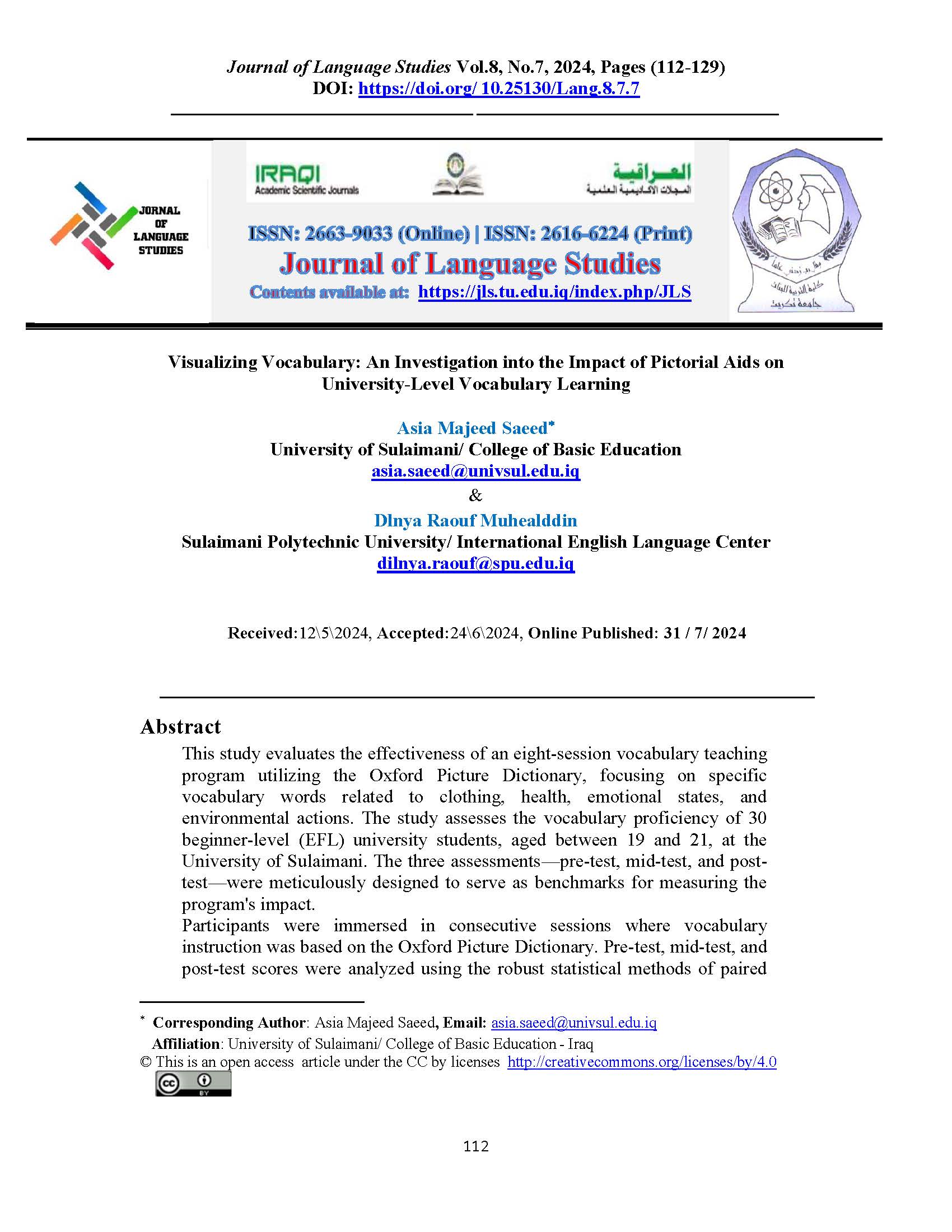Visualizing Vocabulary: An Investigation into the Impact of Pictorial Aids on University-Level Vocabulary Learning
DOI:
https://doi.org/10.25130/Lang.8.7.7Keywords:
Language acquisition, Oxford Picture Dictionary, vocabulary assessment, vocabulary teaching, visual imageryAbstract
This study evaluates the effectiveness of an eight-session vocabulary teaching program utilizing the Oxford Picture Dictionary, focusing on specific vocabulary words related to clothing, health, emotional states, and environmental actions. The study assesses the vocabulary proficiency of 30 beginner-level (EFL) university students, aged between 19 and 21, at the University of Sulaimani. The three assessments—pre-test, mid-test, and post-test—were meticulously designed to serve as benchmarks for measuring the program's impact.
Participants were immersed in consecutive sessions where vocabulary instruction was based on the Oxford Picture Dictionary. Pre-test, mid-test, and post-test scores were analyzed using the robust statistical methods of paired sample t-tests and Analysis of Variance (ANOVA). Several students were also interviewed to gain a deeper understanding of their experiences.
According to the analysis, vocabulary proficiency increased dramatically from the pre-test to the post-test (p < 0.05). Moreover, ANOVA indicated variations in performance across the eight sessions.
The findings suggest that the Oxford Picture Dictionary-based program positively influences vocabulary acquisition. Educators can use this insight to tailor language instruction, benefiting students' language proficiency.
References
• Ahangari, S., Amini, M., & Ahoura, T. (2015). The Effect of Using Visual Aids, Semantic Elaboration, and Visual Aids plus Semantic Elaboration on Iranian Learners' Vocabulary Learning. Journal of Language and Translation, 5(2), 13–21.
• Allen, V. F. (1983). Techniques in Teaching Vocabulary.pdf (p. 136). Oxford University Press.
• Bower, G. H. (1970). Imagery as a relational organizer in associative learning. Journal of Verbal Learning and Verbal Behavior, 9(5), 529–533. https://doi.org/10.1016/S0022-5371(70)80096-2
• Chung, D. T. K. (2023). The Efficacy of Visual Aids in Enhancing Vocabulary Acquisition in EFL Classes. International Journal of Social Science and Human Research, 6(10), 6397–6403. https://doi.org/10.47191/ijsshr/v6-i10-80
• Dunn, R., & Burke, K. (2005). Learning Style: THE CLUE TO YOU LS: CY: Research and Implementation Manual www.learningstyles.net. www.learningstyles.net
• Goldstein, J. A., & Shapiro, N. (2008). Oxford Picture Dictionary (Second edi). Oxford University Press.
• Hama, H. H., & Hussein, H. C. (2024). The Impact of Sticky Note Strategy on Students’ Vocabulary. JOURNAL OF LANGUAGE STUDIES, 8(3), 90–110. https://doi.org/10.25130/lang.8.3.6
• Harmer, J. (2001). The Practice of Language Teaching (Second Edi). London: Longman Group UK Ltd.
• Higbee, K. L. (1979). Recent Research on Visual Mnemonics: Historical Roots and Educational Fruits. Review of Educational Research, 49(4), 611–629. https://doi.org/10.3102/00346543049004611
• Hunt, A., & Beglar, D. (2005). A framework for developing EFL reading vocabulary. Reading in a Foreign Language, 17(1), 23–59. https://doi.org/10.1080/07908310208666643
• Khidhir, R. J., & Omer, O. Q. (2022). The Role of Feedback Comments on Online Posts in Learning English Vocabulary and Phrasal Expressions. JOURNAL OF LANGUAGE STUDIES, 5(4, 1), 1–13. https://doi.org/10.25130/jls.5.4.1.1
• Kim, H. (2019). The Perception of Teachers and Learners towards an Exploratory Corpus-based Grammar Instruction in a Korean EFL Primary School Context. The Korea Association of Primary English Education, 25(1), 123–152. https://doi.org/10.25231/pee.2019.25.1.123
• Kolodii, O., Kovalchuk, I., & Syvak, O. (2017). The Impact of Visualization Techniques on Student's Learning Vocabulary. International Journal of New Economics and Social Sciences, 6(2), 0–0. https://doi.org/10.5604/01.3001.0010.7649
• Nation, I. S. P. (2001). Learning vocabulary in another language. Learning Vocabulary in Another Language, 1–624. https://doi.org/10.1016/s0889-4906(02)00014-5
• Nyikos, M. (2014). Bilingualism and Family: Parental Beliefs; Child Agency. Sustainable Multilingualism, 5(January). https://doi.org/10.7220/2335-2027.5.1
• Rahma Novia Anggraeni, Ngafif, A., & Chasanah, Z. (2021). The Effectiveness of Using Visual Dictionary to Teach Vocabulary at the Grade Students. Scripta : English Department Journal, 8(2), 11–19. https://doi.org/10.37729/scripta.v8i2.1196
• Thornbury, S. (2002). How to Teach Vocabulary (Issue September 2016).

